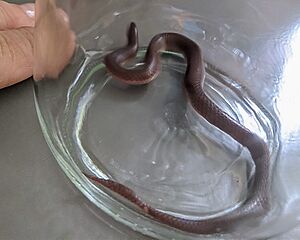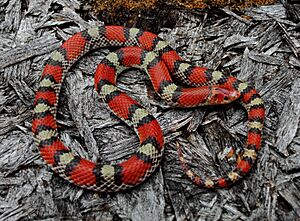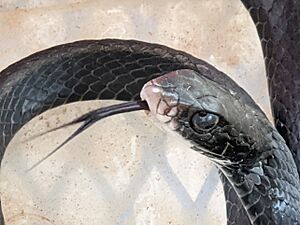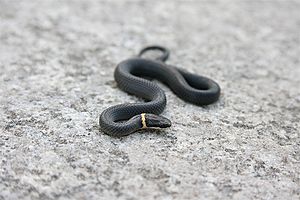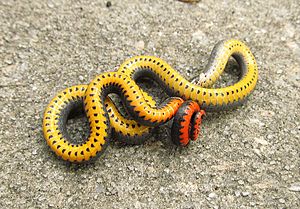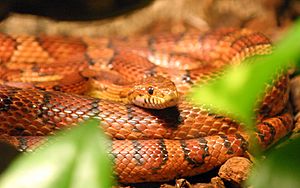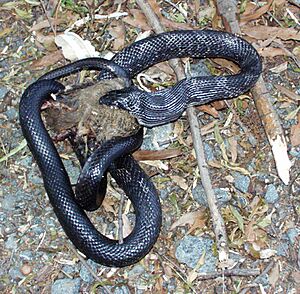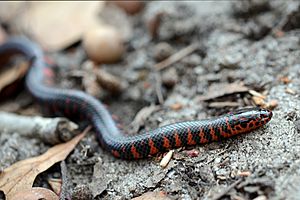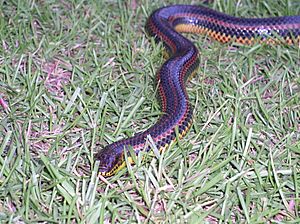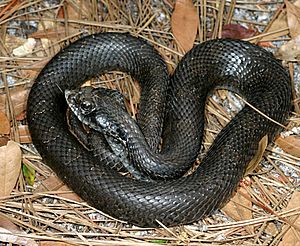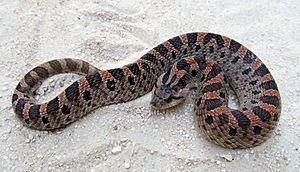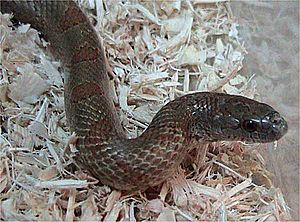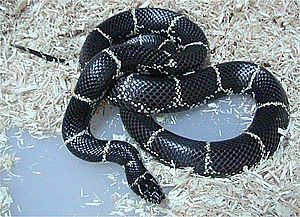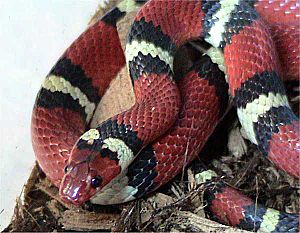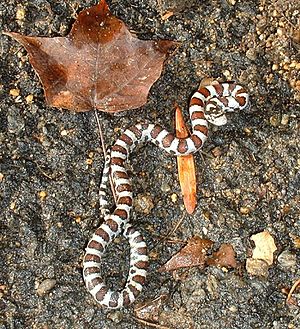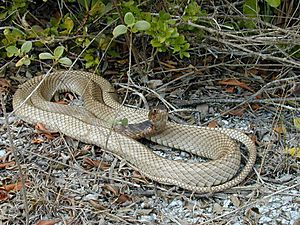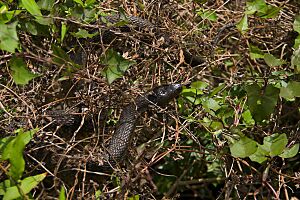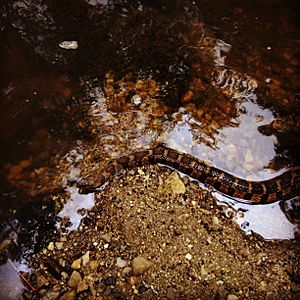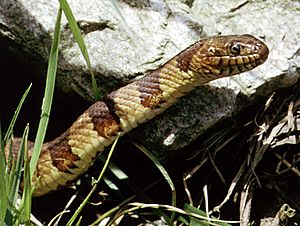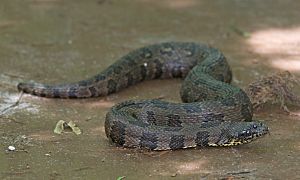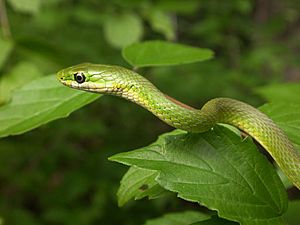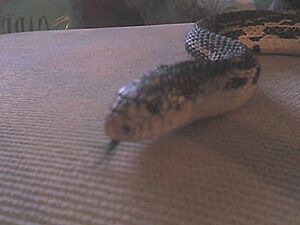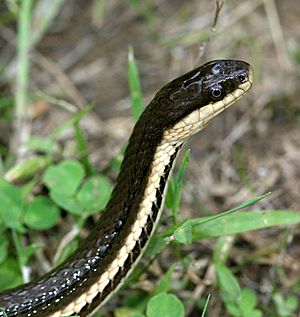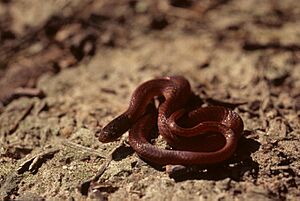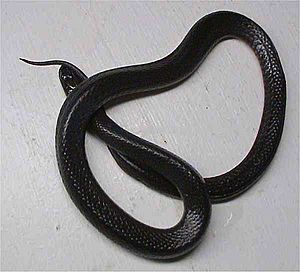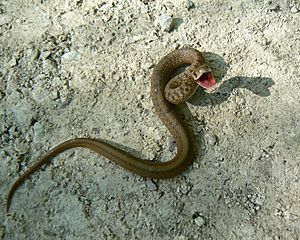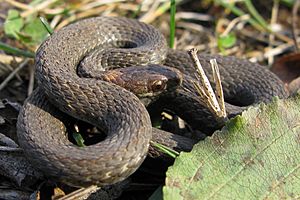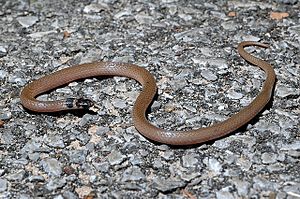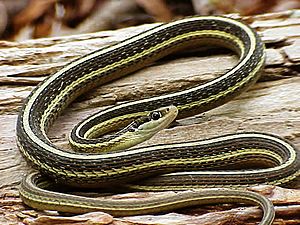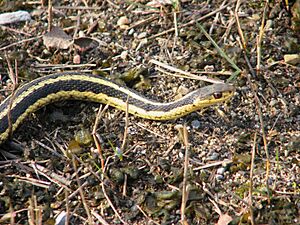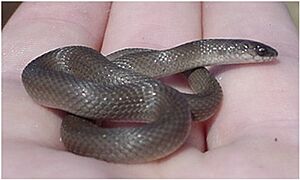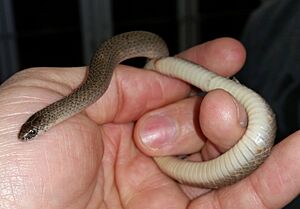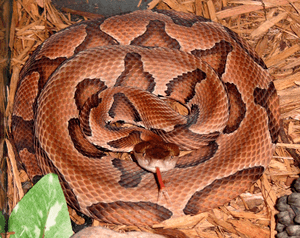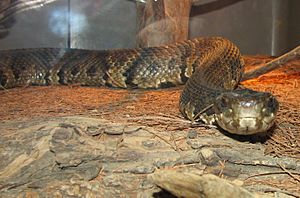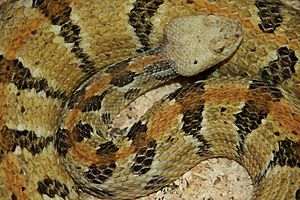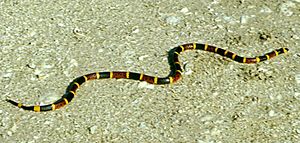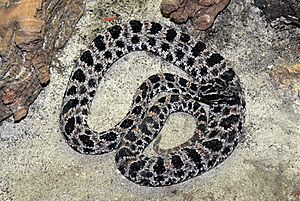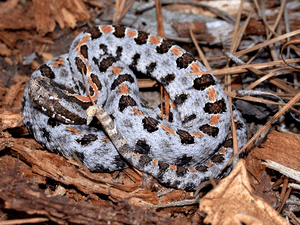List of snakes of South Carolina facts for kids
South Carolina is home to many different kinds of snakes! Some snakes are harmless and help our environment, while others can be dangerous because they are venomous. It's important to know the difference and how to stay safe. This article will help you learn about the snakes you might find in South Carolina.
Snakes That Are Not Dangerous
Most snakes in South Carolina are not venomous, meaning they don't have venom that can hurt humans. These snakes are important for keeping the ecosystem healthy. They help control pests like rodents and insects.
- Eastern Worm Snake (Carphophis amoenus amoenus)
* These small snakes look a bit like worms! They live underground and eat earthworms.
- Scarlet Snake (Cemophora coccinea copei)
* Scarlet snakes have bright red, black, and yellow bands. They are often mistaken for venomous coral snakes, but they are completely harmless.
- Black Racer (Coluber constrictor)
* These fast snakes are usually all black. They hunt during the day and eat many different small animals.
- Northern Ringneck Snake (Diadophis punctatus edwardsii)
* Ringneck snakes are small and have a distinct yellow or orange ring around their neck.
- Southern Ringneck Snake (Diadophis punctatus punctatus)
* Similar to the Northern Ringneck, this snake also has a neck ring and is small.
- Corn Snake (Elaphe guttata guttata)
* Corn snakes are known for their beautiful patterns, often orange and red. They are popular as pets.
- Black Rat Snake (Elaphe obsoleta obsoleta)
* These large, dark snakes are excellent climbers. They often live near farms and eat rodents.
- Yellow Rat Snake (Elaphe obsoleta quadrivittata)
* Yellow rat snakes have yellow bodies with four dark stripes. They are also good climbers.
- Eastern Mud Snake (Farancia abacura abacura)
* Mud snakes live in watery areas and eat eels and salamanders. They have shiny, dark scales.
- Rainbow Snake (Farancia erytrogramma erytrogramma)
* Rainbow snakes are beautiful with iridescent scales that shimmer like a rainbow in the light. They also live in water.
- Eastern Hognose Snake (Heterodon platirhinos)
* Hognose snakes have an upturned snout, like a pig's nose. When threatened, they might play dead!
- Southern Hognose Snake (Heterodon simus)
* Similar to the Eastern Hognose, this snake also has a unique snout and can play dead.
- Mole King Snake (Lampropeltis calligaster rhombomaculata)
* These snakes are often found underground or under logs. They eat small rodents and other snakes.
- Eastern King Snake (Lampropeltis getula getula)
* King snakes are known for eating other snakes, even venomous ones! They are immune to many snake venoms.
- Scarlet King Snake (Lampropeltis triangulum elapsoides)
* These snakes look very similar to venomous coral snakes, but they are harmless. Remember the rhyme: "Red touch yellow, kill a fellow; red touch black, venom lack."
- Eastern Milk Snake (Lampropeltis triangulum triangulum)
* Milk snakes have patterns that can vary greatly. They were once thought to drink milk from cows, but this is a myth!
- Eastern Coachwhip (Masticophis flagellum flagellum)
* Coachwhips are very long and slender snakes. They are fast and hunt during the day.
- Redbelly Water Snake (Nerodia erythrogaster erythrogaster)
* These water snakes have a plain belly that is usually red or orange.
- Banded Water Snake (Nerodia fasciata fasciata)
* Banded water snakes have dark bands or blotches on their bodies. They live near water and eat fish and frogs.
- Florida Green Water Snake (Nerodia floridana)
* These snakes are typically green or brownish-green and live in aquatic environments.
- Midland Water Snake (Nerodia sipedon pleuralis)
* Another type of water snake, often found basking on rocks or logs near water.
- Northern Water Snake (Nerodia sipedon sipedon)
* These are common water snakes with dark blotches. They are often mistaken for venomous cottonmouths.
- Brown Water Snake (Nerodia taxispilota)
* Brown water snakes have square-shaped blotches on their backs. They are excellent swimmers.
- Rough Green Snake (Opheodrys aestivus)
* These slender, bright green snakes live in trees and bushes. They eat insects like crickets and grasshoppers.
- Pine Snake (Pituophis melanoleucus)
* Pine snakes are large and powerful. They often live in sandy areas and eat rodents.
- Glossy Crayfish Snake (Regina rigida rigida)
* These snakes specialize in eating crayfish. They have smooth, shiny scales.
- Queen Snake (Regina septemvittata)
* Queen snakes also primarily eat crayfish, especially freshly molted ones.
- Pine Woods Snake (Rhadinaea flavilata)
* These small, secretive snakes live in pine forests and eat small lizards and frogs.
- Carolina Swamp Snake (Seminatrix pygaea paludis)
* Swamp snakes are small and live in muddy, swampy areas. They eat small aquatic animals.
- Brown Snake (Storeria dekayi)
* These tiny snakes are very common in gardens and urban areas. They eat slugs and worms.
- Florida Redbelly Snake (Storeria occipitomaculata obscura)
* Small snakes with a reddish belly, often found under logs or leaf litter.
- Northern Redbelly Snake (Storeria occipitomaculata occipitomaculata)
* Similar to the Florida Redbelly, these are also small and have a bright red belly.
- Southeastern Crowned Snake (Tantilla coronata)
* These small, slender snakes have a dark "cap" on their head. They live underground and eat centipedes.
- Peninsula Ribbon Snake (Thamnophis sauritus sackenii)
* Ribbon snakes are very thin and fast. They live near water and eat small fish and amphibians.
- Eastern Ribbon Snake (Thamnophis sauritus sauritus)
* Another type of ribbon snake, very similar to the Peninsula Ribbon Snake.
- Eastern Garter Snake (Thamnophis sirtalis sirtalis)
* Garter snakes are very common and can be found in many different habitats. They have stripes down their backs.
- Rough Earth Snake (Virginia striatula)
* These small, brownish snakes live underground or under objects. They eat earthworms.
- Eastern Smooth Earth Snake (Virginia valeriae valeriae)
* Similar to the Rough Earth Snake, but with smoother scales. They are also very small and harmless.
Snakes to Be Careful Around
Some snakes in South Carolina are venomous. This means they can inject venom (a type of poison) if they bite. It's important to know which snakes are venomous and to always give them space. If you see one, the best thing to do is leave it alone and tell an adult.
- Copperhead Snake (Agkistrodon contortrix)
* Copperheads have distinctive hourglass-shaped patterns on their bodies. They are often found in wooded areas.
- Cottonmouth Snake (Agkistrodon piscivorus)
* Cottonmouths, also called water moccasins, are venomous water snakes. They get their name because they open their mouth wide to show a white lining when threatened.
- Eastern Diamondback Rattlesnake (Crotalus adamanteus)
* This is the largest venomous snake in North America. It has diamond-shaped patterns and a rattle on its tail.
- Timber Rattlesnake (Crotalus horridus horridus)
* Timber rattlesnakes have dark bands on a lighter body and a rattle. They often live in forests.
- Eastern Coral Snake (Micrurus fulvius fulvius)
* Coral snakes are brightly colored with red, yellow, and black bands. They are very venomous, but their bites are rare. Remember the rhyme: "Red touch yellow, kill a fellow; red touch black, venom lack." This helps tell them apart from harmless look-alikes.
- Dusky Pigmy Rattlesnake (Sistrurus miliarius barbouri)
* These are small rattlesnakes with a tiny rattle that is hard to hear.
- Carolina Pigmy Rattlesnake (Sistrurus miliarius miliarius)
* Another small rattlesnake, similar to the Dusky Pigmy, also with a very small rattle.


